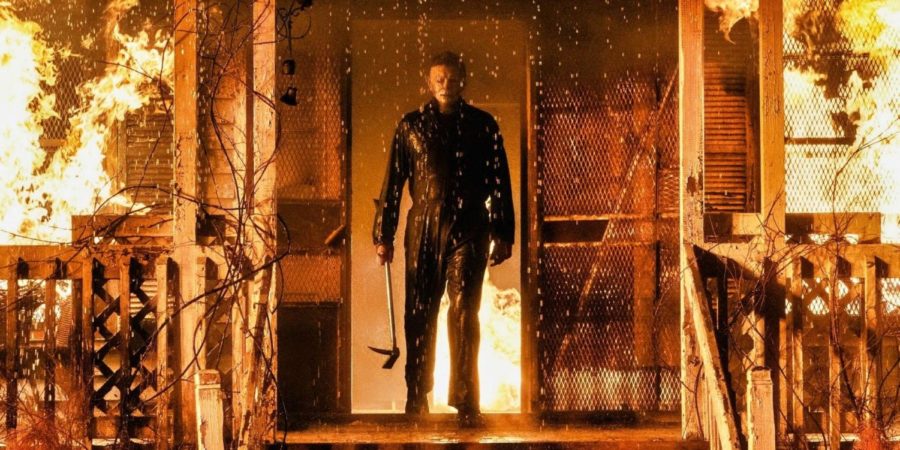“Halloween Kills” shows why 1978’s “Halloween” never needed a sequel
Michael Myers is back for another sequel in the long-running “Halloween” franchise. But should he be?
There is perhaps no horror film as impactful and influential as John Carpenter’s 1978 “Halloween.” Giving birth to the slasher film, “Halloween” created the tropes that would come to define the entire horror genre all while being a damn good movie. Within itself, the film captures a simple fear we all carry whether we know it or not—the fear of the Boogeyman, as represented by the film’s villain, Michael Myers (or The Shape). There is something inherently unsettling about the unknown, whether it be strangers or the shadows that could be hiding in any dark corner around us.
The ghostly white mask of Michael Myers represents this primal fear as he slowly hunts and stalks our main character, Laurie Strode (Jamie Lee Curtis), throughout the entire film. We see him following behind hedges and across the street, progressively getting closer. Combined with the blowing of fallen leaves and the decorating of streets with jack-o’-lanterns in small town Haddonfield, Illinois, a sense of discomfort is perpetually on display, embodying the spirit of the titular holiday. It is with this gradual building of tension that “Halloween” effectively reproduces the anxiety that we all feel when we wonder “what exactly is out there?” The film is a relatively bloodless one, especially considering the future films that would be inspired by it. But “Halloween” doesn’t need gruesome gore to get its terror across, rather it thrives in its constant tension and anticipation of the brutality that surely awaits.
Opening with a continuous POV steadicam shot from a killer as they put on a mask and butcher a teenage girl, the film lingers for as long as it can before finally revealing six-year old Michael Myers with a clown mask, the victim being his older sister. From this moment on, we know pure evil is real, as Myers’ psychiatrist Doctor Loomis (Donald Pleasence) says in many dramatic speeches. There is no rhyme or reason; there is simply the force of nature that is Michael Myers. From there, the film flashes forward 15 years later, depicting his methodical stalking of several teenage babysitters, including the protagonist Laurie. Even though no murders happen during the majority of the film, with really only the beginning and ending having any violence, the pacing and direction constantly make the audience aware of Myers—regardless of his actual physical presence. And when he does finally arrive, the ever-building tension finally pays off as the characters we’ve learned about over the course of the film get dispatched one by one until we are left with only Laurie. All the cliches of slashers come from this film, from the condemnation of sex to the final girl being the most morally righteous character to just the simple idea of having a man with a knife chase around some teenagers.
It is from this classic original that films like “Friday the 13th” and “A Nightmare on Elm Street” would take inspiration, along with many more low quality imitators. With their low budgets and high returns, slasher films were now a lucrative business, each upping the ante in terms of gore, setpieces and sex. Sequels to “Halloween” were sure to follow and they fell into the trap of diminishing returns, trading off the tension and atmosphere of the first film for an ever increasing amount of convoluted storylines and gratuitous violence. With numerous sequels, relaunches and reboots, the series has continuously tried to recapture the magic of the first film while never quite understanding what made it so special.
This can be seen more clearly than ever before in this month’s “Halloween Kills,” the sequel to 2018’s “Halloween” (yes it has the same name as the original), which itself was a direct sequel to the 1978 original that ignored all previous sequels. The second in a planned trilogy, “Halloween Kills” picks up right after the first film did, with this entire trilogy taking place forty years after the original murders. Depicting a traumatized Laurie Strode, portrayed by an older Jamie Lee Curtis, who is still haunted by the events of the original film, 2018’s “Halloween” was an entertaining tribute to the original. Returning to the idea that Michael is a primal force of nature, hell-bent on killing with no other real motivation, the 2018 film managed to have some real scares while still delivering a story on intergenerational trauma, with Laurie, her daughter and granddaughter all teaming up to take on the returning killer. The film also points out that in the modern age of mass shootings and terrorist attacks, a maniac killing three teenagers in one night is relatively insignificant, making it a more personal story between the Strodes and Michael rather than some grandiose tale, as some “Halloween” sequels had tried to do.
Yet in “Halloween Kills,” the franchise regresses, devolving into a mess of bodies, blood and clumsy connections. “Evil dies tonight!” is the line repeated over and over again as the entire small town of Haddonfield forms an angry mob to finally hunt down and kill Michael Myers, changing the scope of the story from a family drama to an… extermination? They, of course, do not prevail, only succeeding in making an ever increasing pile of dumb corpses. With idiotic lines, idiotic characters and idiotic connections to the original—did so many named side character from the 1978 film have to show up again and somehow have some connection with everyone else? The film consistently makes the wrong decisions in its attempt to make a tragic second act. It doesn’t help that the movie doesn’t really have a plot, instead trading an intelligible story and character development for a series of murders, none of which are particularly impressive even from a gore perspective. Tragically, Jamie Lee Curtis really has nothing to do in this movie, just sitting on the sidelines, recovering in the hospital from injuries acquired during the previous film and screaming “Evil dies tonight!” Well, with the state of this franchise, I can only hope that it does indeed die in the next movie, or otherwise my reverence for the original just might.

Shreyas (he/him) is a fourth-year student majoring in biology and philosophy. If he isn't yammering to you about how great "Pet Sounds" is or making bad...


